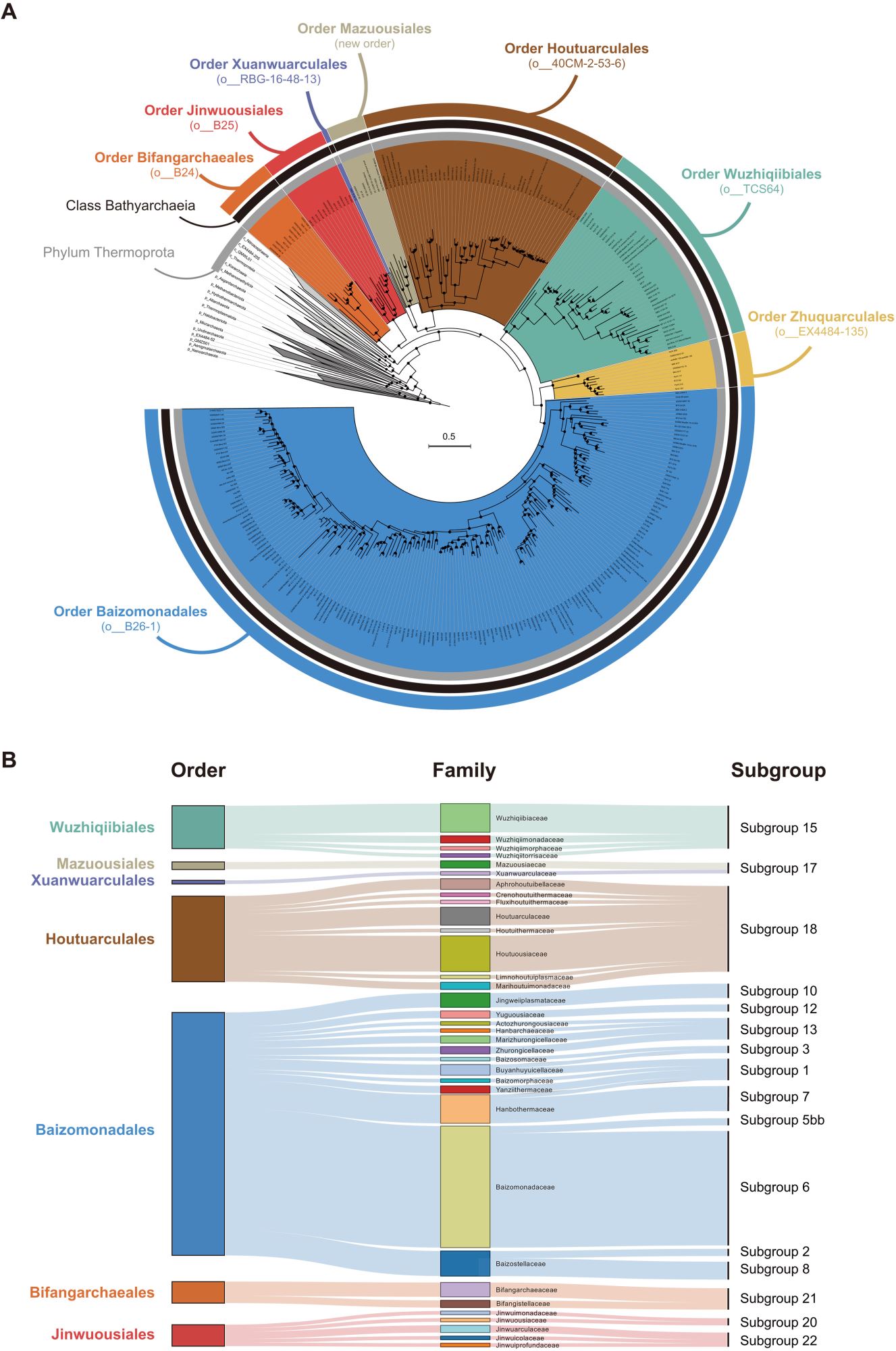Taxonomic and carbon metabolic diversification of Bathyarchaeia during its coevolution history with the early Earth surface envi
Bathyarchaeia, as one of the most abundant microorganisms on Earth, play vital roles in the global carbon cycle. However, our understanding of their origin, evolution, and ecological functions remains poorly constrained. Here, we present the largest dataset of Bathyarchaeia metagenome assembled genome to date and reclassify Bathyarchaeia into eight order-level units corresponding to the former subgroup system. Highly diversified and versatile carbon metabolisms were found among different orders, particularly atypical C1 metabolic pathways, indicating that Bathyarchaeia represent overlooked important methylotrophs. Molecular dating results indicate that Bathyarchaeia diverged at ~3.3 billion years, followed by three major diversifications at ~3.0, ~2.5, and ~1.8 to 1.7 billion years, likely driven by continental emergence, growth, and intensive submarine volcanism, respectively. The lignin-degrading Bathyarchaeia clade emerged at ~300 million years perhaps contributed to the sharply decreased carbon sequestration rate during the Late Carboniferous period. The evolutionary history of Bathyarchaeia potentially has been shaped by geological forces, which, in turn, affected Earth’s surface environment.

Fig. 1. The newly improved taxonomy and subgroup assignment of the class Bathyarchaeia.
(A) Phylogenomic affiliation of 304 representative Bathyarchaeia MAGs refined from publicly available databases and our laboratory datasets based on a concatenated alignment of 122-archaeal marker proteins implemented in GTDB-Tk by using IQ-TREE2 with LG+F+R10+C60 model and Shimodaira Hasegawa–like approximate likelihood ratio test with 1000 bootstrap replicates (bootstrap higher than 0.9 are shown with black dots). The colored background and outer rings denote the eight proposed orders of class Bathyarchaeia, and the inner black and gray rings represent the whole class Bathyarchaeia and phylum Thermoproteota, respectively. The number of MAGs used in the phylogenetic analysis is listed under the name for each taxonomic lineage. (B) Taxonomic assignment of subgroups for the representative Bathyarchaeia MAGs with 16S rRNA genes. The phylogenetic tree was constructed with subgroup-classified sequences from Zhou et al. as a reference by using RaxML 8.2.12 with -m GTRGAMMA -N autoMRE and 1000 bootstrap replicates (fig. S2).

Fig. 2. Evolutionary history of the class Bathyarchaeia and timing correlations with major geological activities.
(A) Phylogenomic tree and estimated divergence times of the major Bathyarchaeia lineages. The whole tree was constructed on the basis of 259 Bathyarchaeia and 190 reference MAGs by the concatenated alignment of their SMC and 16 conserved proteins (fig. S9). Different color schemes represent the descendent lineages for eight Bathyarchaeia orders (the label of order Xuanwuarculales is removed as the only one MAG). The divergence ages of major nodes are numbered 0 to 13 and labeled with the posterior 95% CIs (flanking horizontal blue bar). The relative proportions of juvenile crust through time are represented as a brown bar chart in the top panel. The vertical pink, green, and yellow bands indicate the first subaerial continent exposed above the sea at 3.46 to 3.2 Ga ago, rapidly increasing subaerial landmass at ~2.5 Ga ago, and the global submarine volcanism intensively occurred at 1.88 to 1.7 Ga ago , respectively. (B) Evolutionary timeline of the Bathyarchaeia lignin-degrading lineage and contemporaneous Permo-Carboniferous coal peak. The tree is part of the whole phylogenomic tree of Bathyarchaeia, comprising nine MAGs from the genus Baizosediminiarchaeum. The four MAGs with pink background, which were specifically recovered from the lignin enrichment, are designated as the lignin-degrading Bathyarchaeia clade in this study. The MAGs labeled with the number “8” within the purple box are assigned to the previous subgroup 8. The top panel shows the burial flux of terrestrial organic sediments accumulated in North America through time and contemporaneous key evolutionary time points for terrestrial plants , white rot fungi , and xylophagous beetles.
Link: www.science.org/doi/full/10.1126/sciadv.adf5069

